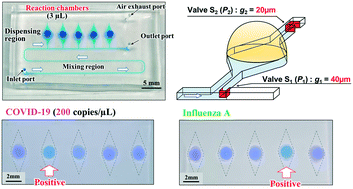A method of sequential liquid dispensing for the multiplexed genetic diagnosis of viral infections in a microfluidic device†
Abstract
In this study, we introduce polydimethylsiloxane (PDMS)-based microfluidic devices capable of sequential dispensing of samples into multiple reaction microchambers in a single operation to provide a fast and easy sample-to-answer platform for multiplexed genetic diagnosis of multiple viral infectious diseases. This approach utilizes the loop-mediated isothermal amplification (LAMP) method to amplify and detect specific nucleic acid (DNA/RNA) targets. We present a microfluidic flow control theory for sequential liquid dispensing phenomena, which provides design guidelines for device optimization. The device specifications, such as the possible dispensing number and maximal allowable flow rate, can be theoretically designed by optimizing the geometric dimensions of the microchannels and a pair of passive stop valves integrated into each microchamber together with the water contact angles of the materials used to fabricate the microfluidic devices. In addition, a passive stop valve with a vertical-type phaseguide structure was designed to improve device performance. We could simultaneously diagnose coronavirus disease 2019 (COVID-19) and other infectious diseases, such as severe acute respiratory syndrome (SARS), seasonal influenza A, and pandemic influenza A (H1N1) 2009. The colorimetric reverse transcription LAMP (RT-LAMP) assay suggests that the four viral infectious diseases can be detected within 30 min using a hue-based quantitative analysis, and the naked eye using our microfluidic devices.

- This article is part of the themed collection: Miniaturised Sensors & Diagnostics


 Please wait while we load your content...
Please wait while we load your content...